Donut tires, also known as space-saver or temporary tires, are the latest evolution of spare tires. Sure, they look funny, especially on modern cars with larger wheels, but if used properly, they can be a viable solution when you have a flat tire.
Today, most modern cars come with a donut spare tire in the trunk. However, you can also purchase a spare tire yourself and free precious space in the trunk. But how will you find the perfect donut tire for your car? Let’s dig into more detail and find the best solution for you.
Donut tire is a designation used for the combination of narrow tire and smaller steel wheel. In North America, the term temporary tire also applies to the same product, while in Europe, you can find it as a space-saver tire.
These tires are designed to be used only as a spare tire, and only in case of emergencies. You shouldn’t use these tires for everyday driving, and especially if you drive on the highway. In other words, use them until you repair the damaged tire.
There are many reasons why car manufacturers utilize these tires, and it all starts with the cost. A full-size spare tire will cost much more than a donut spare tire, which can reflect on the vehicle’s sticker price. More accurately, cars with a donut spare tire will be more competitive thanks to the lower prices.
Furthermore, spare tires also free up cargo space. The difference is not significant, especially in larger cars. Nevertheless, car manufacturers can brag about a few more cubic inches of cargo space if they opt for a donut spare tire, which, again, makes them more competitive on the market.
Crucially, though, the temporary spare tire is much lighter than a regular tire and wheel combo. This means that the whole car will be lighter, which positively affects performance and fuel economy. Moreover, it lets car manufacturers keep exhaust emissions at check.
With that said, donut tires also have disadvantages. Primarily they are much worse in terms of performance and have limited traction and braking capabilities.
Donut tires last for a long time, especially if you don’t experience flat tires that often. However, if you are among the unlucky people that experience that more often, you might need to replace your donut tire after a few driving stints.
Tire manufacturers recommend driving up to 70 miles before replacing the donut tire, so it’s best not to use that distance at once. I’ve seen some people use these tires for longer, but that’s not advisable because it’s not safe.
Meanwhile, some people opt for donut tires to save space inside the trunk, or when they don’t have a viable full-size spare tire. Also, in some countries that drive on CNG or LPG, the tank for these fuels is usually installed into the spare-tire well, and a narrower donut tire is the only option.
Like regular tires, the donut models are also not created equally. Many brands offer temporary tires at various price points, which makes the purchase decision harder. Here is what you need to look out for when purchasing donut spare tires.
You should always purchase donut tires that have a similar diameter to your existing tires. And, by diameter, I mean the whole wheel – not just the rim. Otherwise, you risk damaging the stability of your car.
Fortunately, you can find many spare tire sizing charts, where you can compare the diameter of temporary spare tires with the diameter of your tire and wheel combo. Some websites will also show you only donut spare tires that fir your car, provided you enter the dimensions of your existing tires.
Or, you can also do the math on the diameter of your tires by following this detailed guide on Tire Rack.
Due to the narrower tread, but also the lower-quality tread compounds, temporary spare tires shouldn’t be used like normal tires.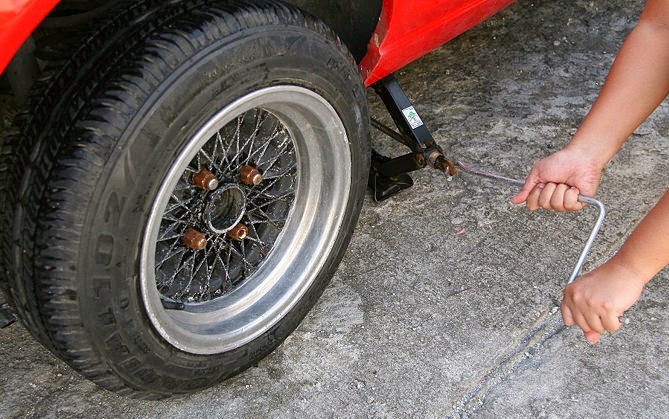 Simply put, these tires lack enough traction for normal driving, and they also don’t last very long, especially if used at higher speeds.
Simply put, these tires lack enough traction for normal driving, and they also don’t last very long, especially if used at higher speeds.
Each donut spare tire should only be driven at speeds up to 50 mph. Also, it would help if you were more careful in the corners, especially when it rains. Moreover, space-saver spare tires don’t last very long – they can only be used up to 70 miles.
Like with most things, there is a large price difference between various donut spare tires. Every large tire manufacturer produces temporary tires, including Bridgestone, Continental, and Pirelli. However, you can also find some budget alternatives from no-name brands.
Even though the premium and cheap donut spare tires adhere to the same limits (50mph and 70 miles), premium brands offer superior tires in terms of performance and durability. However, they are also much more expensive – temporary spare tires cost from $50 to $300. In the end, it’s your choice.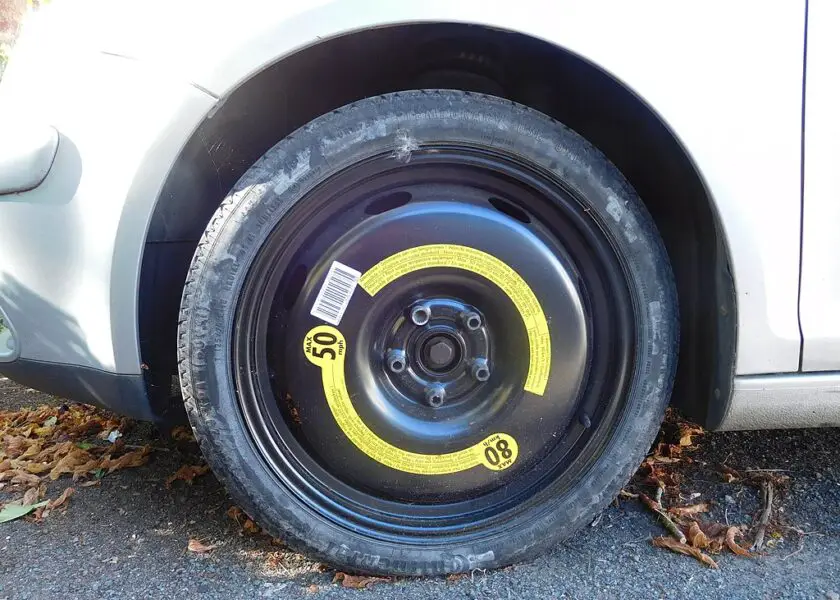
You can find donut spare tires in every single place that sells normal tires, including your nearest tire shop, but also a well-equipped gas station.
For lower prices, though, I recommend purchasing these products online. Places like Tire Rack, Discount Tire, Auto Zone offer a wide range of donut spare tires, including products from respected tire manufacturers. You can also find low-cost options on Amazon and Walmart.
I hope that this article helped you find the right donut spare tire for your car. Regardless of the brand you choose, always adhere to the limits set by the manufacturer – 50 mph and 70 miles of range.
Also, if you found this article useful, share it with your friends – it might help them the next time they purchase donut spare tires. Or, if you still scratch your head about something, please do not hesitate to ask your question in the comment section below – we’ll be happy to help!
Do you ever wonder why a spare tire is standard equipment in your vehicle? Well, a flat tire can be frustrating and will most likely happen when least expected.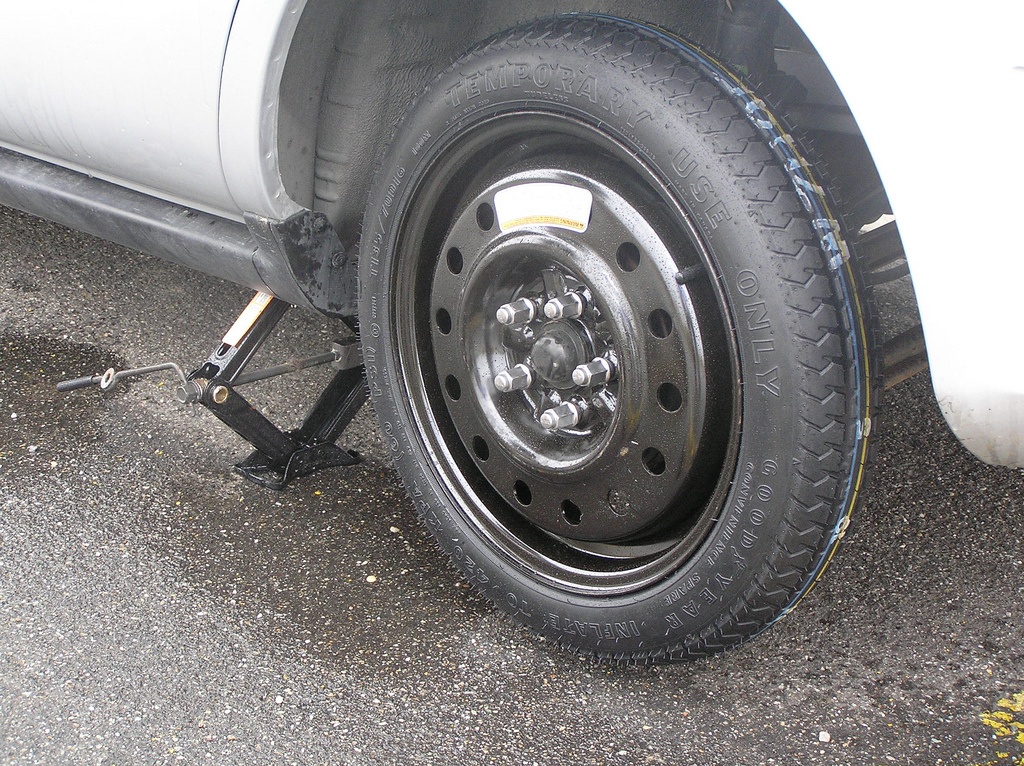
Carrying a spare tire is no doubt essential when traveling, especially on long-distance trips. Although some modern cars do not come with spare tires, a spare tire is a handy and vital component of a vehicle when it comes to inconveniences caused by flat tires. Having a spare tire in your car not only enhances your safety but also saves you the stress that comes with getting a flat tire. In this guide, we’ll learn all about flat tires, from why it is essential to have one to the precautions you should take when using spare tires to ensure they are in good condition and of good quality.
Nobody likes the idea of getting stranded on the road because of a flat tire emergency, and that is why having a spare tire in your vehicle is always essential. However, it’s also necessary that you know how they operate and how you can ensure your safety when using them.
Our main intention is to ensure you are informed on everything about spare tires to ensure your safety. Besides the importance of having a spare tire, we’ve gathered more information about spare tires from various experts such as the National Highway Traffic Safety Administration (NHTSA) and Federal Motor Vehicle Safety Standards (FMVSS). We’ve also addressed what the National Safety Council advises on using spare tires, with safety being our most priority. At the end of this read, you should be able to make wise decisions as far as spare tires are concerned.
We’ve also addressed what the National Safety Council advises on using spare tires, with safety being our most priority. At the end of this read, you should be able to make wise decisions as far as spare tires are concerned.
A spare tire, also known as Stepney, refers to an extra tire carried for an emergency and can be used to replace a regular tire if it has a blowout, goes flat, or has any other emergency. It’s a temporary spare wheel that is smaller and lighter than standard tires.
A spare tire is typically smaller in diameter than the usual tire in an attempt to save on space and lower the vehicle’s weight instead of a full-size tire, which would take a lot of space and increase the vehicle’s weight. However, there’s also a full-size spare tire.
Getting a flat tire when least expected is quite frustrating and no one wishes to encounter it. When you drive long distances or travel a lot on rough roads, you’ll need a spare tire. Getting a flat tire in the middle of nowhere could mean you’re far away from the nearest repair shop, and you need that quick fix to get you there.
Getting a flat tire in the middle of nowhere could mean you’re far away from the nearest repair shop, and you need that quick fix to get you there.
Spare tires are valuable during an emergency. They can be used to get to a car repair shop or get home safely. Spare tires are a practical alternative to sealants or inflater kits, which need extra expertise to handle and operate and can cause damage to the tires if not used properly.
Here are a few things that you should know about spare tires.
Have you ever wondered what type of spare tire you can purchase for your car? Well, there are several types of spare tires to choose from, and it is essential to know the available spare tires. You should keep in mind the following options when purchasing a spare tire.
This spare tire matches the original set of tires on the vehicle. It’s the most versatile spare tire by far, as it is identical to the car wheels. Full-size spare tires can either be matching or non-matching spare tires.
It’s the most versatile spare tire by far, as it is identical to the car wheels. Full-size spare tires can either be matching or non-matching spare tires.
The full-size matching spare tires match the vehicle's regular tires, while the full-size non-matching spare tires do not match the regular tires. Keep in mind that the non-matching spare tires may not aesthetically match the normal wheels and tires of the vehicle.
Some midsize SUVs like the Isuzu mu-X are accompanied by full-size spare tires. The full-size spare tire offers a long-term solution and may not require you to drive to the repair shop immediately. It is, therefore, more flexible and reliable, but it requires a lot of storage space in the vehicle.
These spare tires happen to be lighter than the full-size spare tires and are characterized by shallow tread depth. They are easier to install and do not add a lot of weight to the car as opposed to full-size spare tires. However, they also occupy a lot of space, just like the full-size spare tires.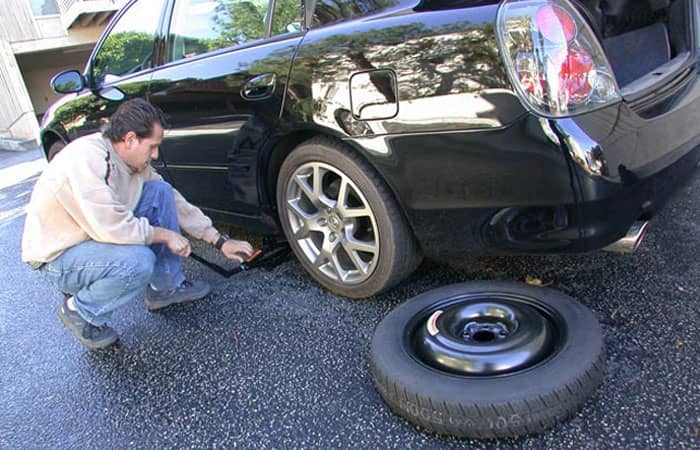
These spare tires have smaller dimensions and require more inflation pressure than the standard spare tires. They are lightweight and have shallow tread depth. They are designed for limited or restricted usage and can impair some vehicle features such as the traction control, the ABS, or even the speedometer’s operation.
This spare tire is smaller in diameter compared to the standard car wheels and is used for short-term emergency fixes. While the donuts occupy smaller space, however, they can only operate at low speeds. A general rule to always remember is to not drive a donut spare at a faster speed than 80 miles per hour. They are for temporary usage and are not intended for highway use as well.
These are temporary spare tires that are also inflatable or collapsible. They take the least storage space but a little more challenging to install. They are only intended for limited usage to get you to the nearest garage.
This video explains all you need to know about spare tires.
Apart from the full-size matching spare tire, spare tires are different from regular car tires. The spare tires are designed for temporary short-term use during emergencies and to save on space. The spare tire wheel is generally made of lightweight material, and the tread depth is shallow compared to the regular tires. The compact or the donut spare tires have smaller diameters which help to save on space.
Some tires are smaller than the original tires and are known to be temporary spare tires. Such tires cannot operate on long distances or at faster speeds.
Are you wondering how long you can drive on a spare tire? Depending on the kind of spare tire you have, the actual mileage will vary. However, you must replace the spare as soon as possible for your safety when driving.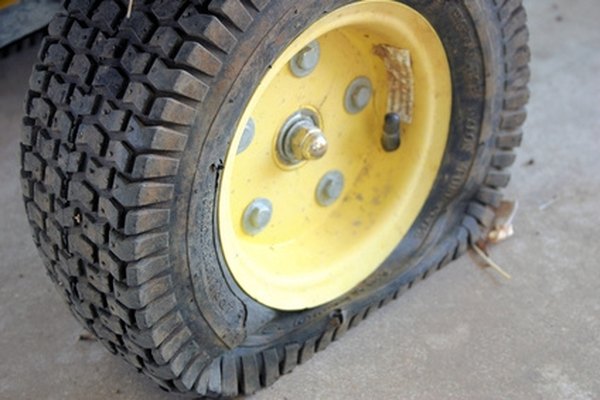
The donut spare tires are not meant for long-distance trips. It is also advisable to drive them at a range of 50-60 mph. It is, therefore, essential that you consult with the manufacturer’s manual for more informed information.
The spare tires are meant to enable you to reach the nearest repair shop or reach home safely. The American Automobile Association (AAA) advises that when driving the donut spare tire, one should not exceed 50 miles. Long-distance driving can potentially lead to damage to other parts of the car, such as the transmission.
Maybe you’ve just had a puncture, and you’re late and wondering how fast you should drive on the spare tires. Keep in mind that the exact speed limit of spare tires is in most cases indicated on the tire. However, the general thumb rule is not to drive more than 50 mph with the temporary mini-spare tire. You should instead avoid highways as possible and try to get to a repair facility.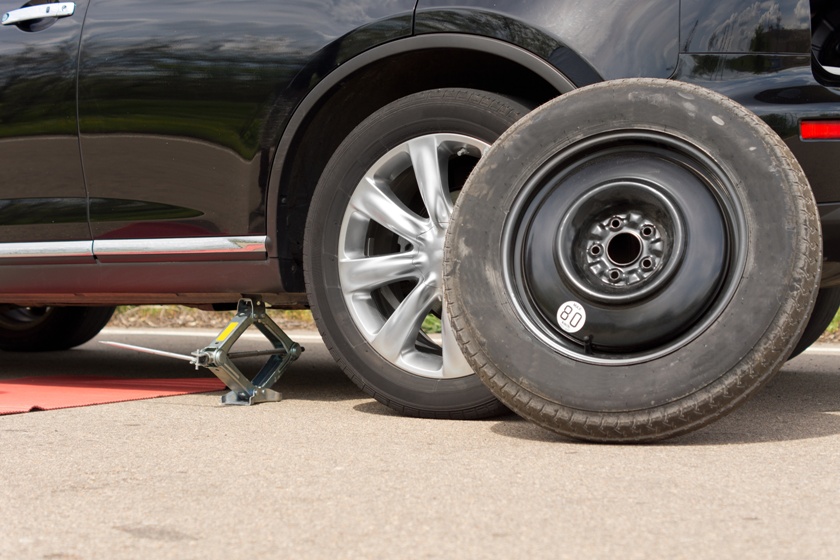
In any case, you’re in an unfortunate situation, and you’re forced to drive on a spare tire, you should make sure that you stick to the recommended limit to ensure your safety on the road. If needed, you should drive in the slow lanes.
Another essential thing to note is that driving on a spare tire is not safe for you and your car, and the faster you drive, the worse it becomes.
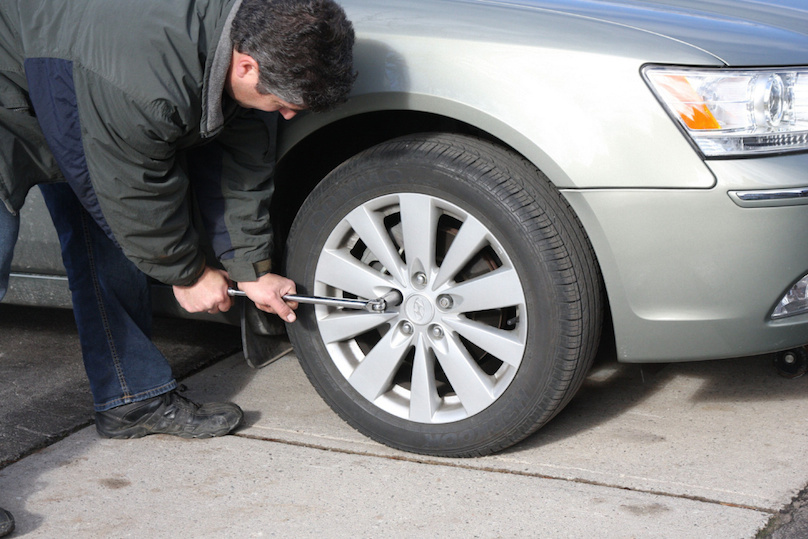 Significant damages could also happen to the car axle and other parts, not forgetting the potential damage that can be caused when you encounter a car crash.
Significant damages could also happen to the car axle and other parts, not forgetting the potential damage that can be caused when you encounter a car crash.The use of donut or mini-spare tires is because of the limited space in the vehicle or the manufacturers seeking to limit cost or weight. The donut spare tires take less space and require lower prices than full-size spare tires, which translates to more profits for the car manufacturers.
They are also lighter than the other spare tires, and this helps with fuel economy. With all that said, anything less than a full-size spare tire to the consumer can be pretty compromising when a puncture occurs.
You don’t need to wait until you have a tire emergency to think of investing in a spare tire. If your car is not equipped with a spare tire, you must purchase a spare tire. This comes in handy when you need to replace the damaged tire and drive safely to the nearest car service or garage.
If you find out that your car is not equipped with a spare and you decide to get one, you can purchase it at any tire store or tire dealership near you.
You can also get spare tires online from Amazon and Walmart. However, it is important that you pay attention to the product description to ensure that the tire you’re about to purchase is compatible with your particular car.
Temporary spare tires vary in cost. The main factors that affect the cost include the place where you purchase the tire and the size of the tire.
The main factors that affect the cost include the place where you purchase the tire and the size of the tire.
Donut spare tires can cost as low as $50 but can rise as high as $300 and beyond. The cheapest place to buy a spare tire would be a local spare tire shop near you.
As a car owner, it’s hard to imagine owning a vehicle that lacks a spare tire. The reality is that you may encounter a car that doesn’t have a spare wheel at one point in life. You may want to buy a spare wheel to avoid any inconvenience. In this case, you ought to explore these essentials when buying yourself a spare tire:
Consider the available storage space: It is important to consider where you will store your spare tire.
The compatibility of the spare tire: pay attention to the compatibility of the tire to ensure you buy a spare tire that is compatible with your vehicle.
Depending on the vehicle’s needs and your driving habits, you may choose to buy more than one spare.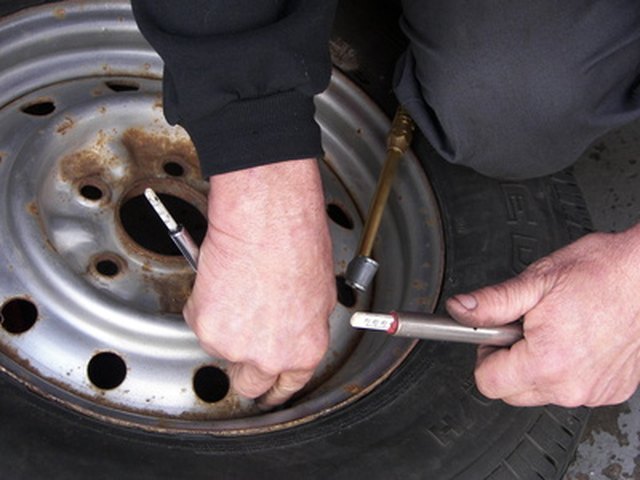 Alternatively, you may upgrade from the small space-saving tire to a full-size spare tire to allow full vehicle function.
Alternatively, you may upgrade from the small space-saving tire to a full-size spare tire to allow full vehicle function.
A qualified technician can guide you in acquiring a spare tire and the process of mounting a replacement spare tire.
The right answer is ‘NO.’ Spare tires are called temporary tires for a reason. Don’t try to fix the spare tires because the rubber used is of inferior quality compared to the regular car wheels. The spare tire’s trade is also not as deep as the normal tire. The solution is to purchase a new spare tire.
Maybe you have a spare tire, but you’re fortunate enough not to have used it. Good for you! You don’t need to replace the spare tire as often as you may have thought! Unused spare tires can last over ten years, whether your spare tire is a donut spare tire or a full-size spare tire.
The rubber tends to break down over time due to chemical reactions.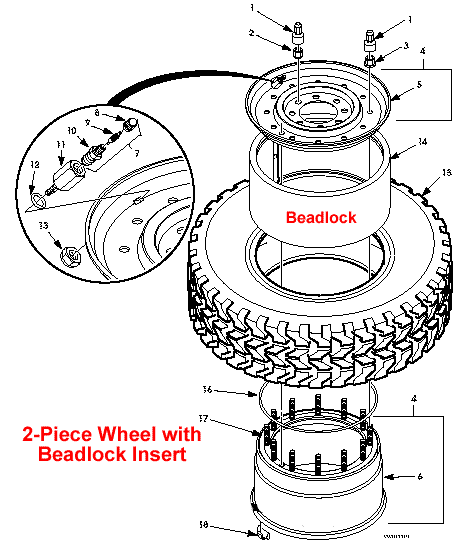 The spare tire may look okay, but the tire's structural integrity gets compromised over time even when not used.
The spare tire may look okay, but the tire's structural integrity gets compromised over time even when not used.
There are several models of cars that don’t offer spare tires, including Chevrolet and Buick. For this reason, many people don’t realize they lack a spare tire until they find themselves in a situation that needs one.
According to the AAA estimates in 2012, out of seven cars bought, one lacks a spare tire, says Mike Caskins, the technical service manager at AAA’s national headquarters. Manufacturers are going with carbon fiber and lightweight car designs to save weight and ensure better fuel economy.
Flat tires can occur when least expected; having an inflated spare tire comes in handy. There are several essentials to remember when driving on spare tires to ensure you arrive safely to your destination.
The small donut spare tires should be maintained with 60 PSI inflation pressure and are restricted to overspeed past the required speed limit.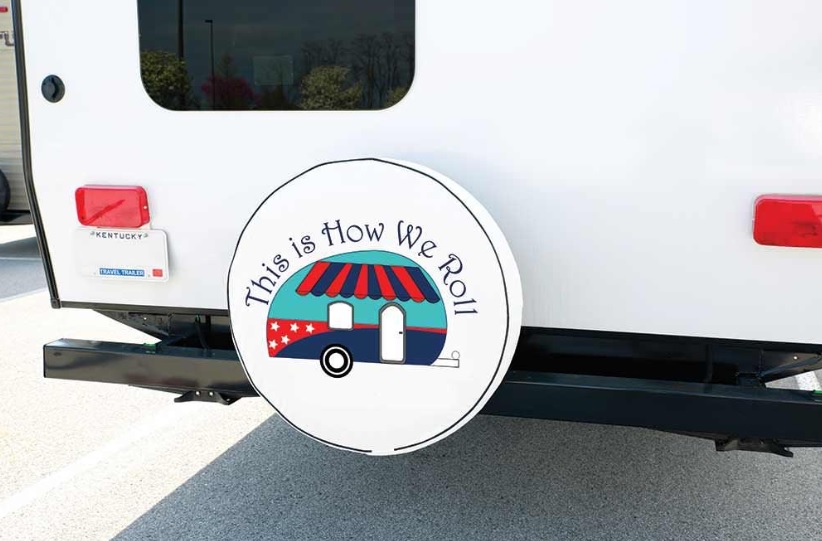 Donut spare tires are driven at no more than 80 km/h or 50 miles per hour.
Donut spare tires are driven at no more than 80 km/h or 50 miles per hour.
Spare tires should be removed as soon as possible by replacing or repairing the original tire. The presence of any differences in tire traction can increase braking distances, especially during an emergency. Tire traction differences can also reduce vehicle handling.
Spare tires are developed to help users regain mobility in the event that a blowout, a cut, or a puncture causes a flat tire emergency. Compared to full-size spares, the compact spare tires are not designed for long-term use because they are lightweight and small, with narrower tread.
When a temporary spare tire is used in driven-wheel positions, tire revolution differences require the car driveline to continuously compensate for the wear, increasing heat and the possibility of the vehicle’s failure.
This happens especially for four-wheeled vehicles as well as any vehicles equipped with a limited-slip differential. For this reason, many car manufacturers recommend using spare tires in non-driven wheel positions to avoid wear or failure of the vehicle.
Temporary spare tires that come with a particular vehicle are only designed to fit that vehicle. Never attempt to change or use the spare tire on another vehicle unless the wheel is of the exact model and make.
Before you drive on your spare tire, there are essential things to know about spare tires:
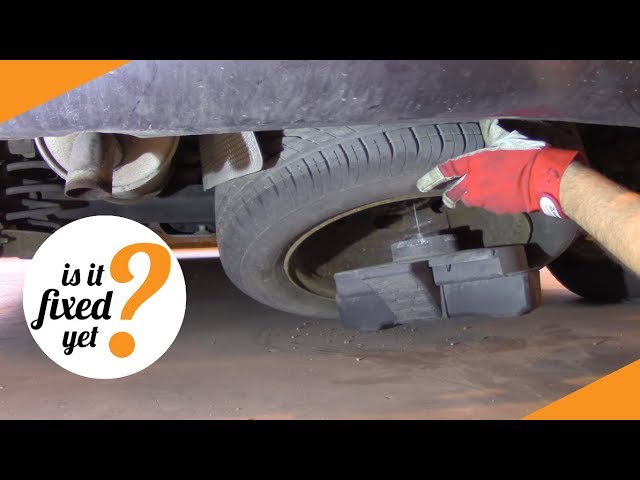
In automobiles, spare tires are stored in spare tire wells - an area in the car's trunk, often in the center, where spare tires are stored when they're not in use. In most cases, the spare tire is secured with a wing-nut fastener and a bolt.
In most cases, the spare tire is secured with a wing-nut fastener and a bolt.
Sometimes the spare tires are stored in a cradle under the rear of the vehicle. For security reasons, the cradle is secured by a bolt that is only accessible from the inside of the trunk. This arrangement is advantageous over storing the spare tire in the trunk, including saving space and not having to remove contents from the trunk to access the spare wheel.
However, storing spare tires in the cradle can also be disadvantageous because the tire gets dirty or dusty. The changing of the tire can thus be unpleasant and can also rust on older cars making it difficult to remove the spare tire.
Many off-road vehicles and Sport Utility Vehicles have their spare tires mounted externally, either on the side, the top, or even on the hood or bonnet.
Like mid-engine cars, the spare tire is stored in the front boot in the rear-engine vehicles. Some vehicles, such as the first-generation Fiat Panda and the Subaru Leone, keep their spare tires in the engine bay.
Perhaps you just invested in a spare tire, and you’re wondering how you’re going to ensure that your tire lasts longer. Well, you are encouraged to inspect your spare tire each time the regular tires get rotated. This service is recommended in order to maximize the spare tire’s life.
You can kindly ask the tire technician to help you check the condition of your spare tire when your car is being serviced at the garage. However, if you decide to perform the process yourself, you can simply pull the spare outwards to ensure the spare tire is properly inflated and in good condition.
The NHTSA recommends that if a spare tire of any kind accompanies your vehicle, ensure that you frequently check its pressure. It is frustrating enough to get a flat tire; you don’t want to discover that the spare you have is also in the same condition.
Consumer reports on tire safety indicate that spare tires need to be inspected regularly and at least replaced after 8-10 years. This is with the exception in case the owner suggests that the spare tire should be changed sooner.
This is with the exception in case the owner suggests that the spare tire should be changed sooner.
If you’ve recently shopped for a new car, you may have probably noticed that a spare tire was missing. How is that possible? Consumer reports indicate that newer models continue to flock to the market, with spare tires not being standard equipment anymore. About 35% of cars from the factory come without a spare tire. There are several explanations for not including spare tires:
To improve fuel efficiency and economy: some manufacturers do away with spare tires to reduce the car weight to improve the fuel efficiency. The fuel economy ratings play a big role in the marketing strategy of vehicle models and the overall brand’s average fuel consumption.
Some vehicle brands, such as the new BMW, do not include spare tires. They are instead equipped with run-flat tires, which feature stiff internal reinforcement. However, it’s hard to find run-flat tires, and they’re more expensive than spare tires, which makes the consumer wonder why they don’t provide spare tires.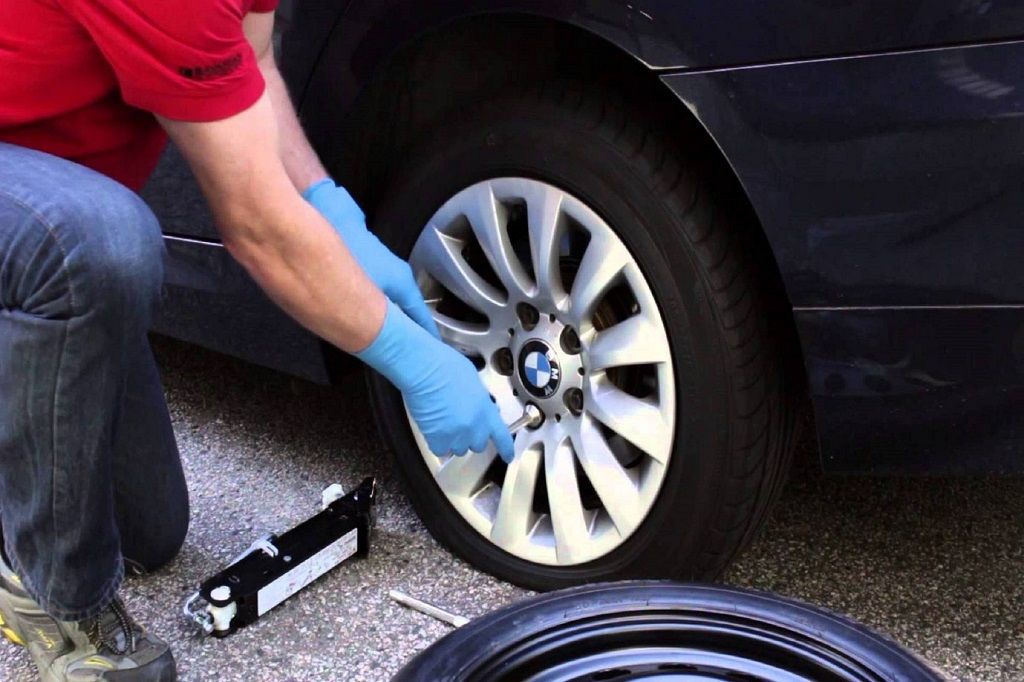 Hyundai automakers also pinpointed to replace spares with tire mobility kits, explaining that it’s a matter of saving weight and not cost savings.
Hyundai automakers also pinpointed to replace spares with tire mobility kits, explaining that it’s a matter of saving weight and not cost savings.
Car manufacturers are finding alternative ways to reduce car weight in order to improve their efficiency and improve the fuel economy. In simple words, reducing the car weight helps increase fuel economy.
To improve mileage: automakers have resorted to ditching spare tires to lower the weight of the car, which is regarded as the easiest way to improve mileage in a vehicle. A car tire with a jack weighs approximately 40 pounds.
Space considerations: the increasing popularity of EVs and hybrid cars gives automakers another reason not to include spare tires. The car manufacturers encounter challenges when designing cars that require both battery packs and electric motor or gas engines. The battery ends up being placed in the trunk or under the rear seat.
For this reason, automakers find it sensible to locate the electric or hybrid battery systems in the trunk meant for a spare tire in order to maximize the cargo and passenger volume of the alternative fuel vehicles.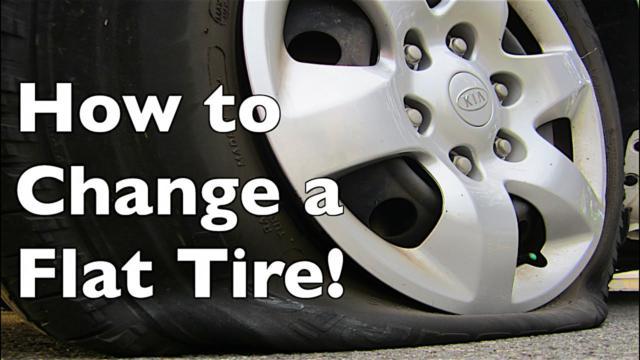 Of course, this isn’t a big problem for large vehicles, but most alternative powertrain vehicles are small.
Of course, this isn’t a big problem for large vehicles, but most alternative powertrain vehicles are small.
Saving on costs: automakers tend to save money when they don’t include spare tires. They are concerned with the weight of the car and the added costs that come with spare tires. Most manufacturers do not see the need to include a spare tire, while there are other alternatives to either donut or full-size spare tires.
AAA recommends that car owners should take the initiative to know whether their cars have spare tires before they need them. Also, if you are looking forward to buying a new car, find out which manufacturers or car dealers include spare tires. Make sure to take a peek in the car’s trunk before you get stranded with a flat tire, only to notice you don’t own a spare tire.
If you’ve never encountered a car without a spare tire, you’re probably wondering which cars don’t have a spare tire at all. AAA gives us a list of vehicles that lack spare and among them include - BMW 2,3,4 and 6 series, Dodge Viper, Hyundai Accent, Jaguar F-Type, Jeep Compass, Mercedes-Benz E-Class, Nissan GT-R, Porsche 718 Cayman, Porsche Panamera, and Tesla Model X.
AAA advises car owners not to assume that there’s a spare tire and if there’s one, find out if the spare is optimal. The spare tire pressure should also be checked regularly.
While flat tires and blowouts don’t happen more often, you may be caught unaware and be stranded in the middle of nowhere. The last thing you want is to waste time while on your long journey. If your car doesn’t have a spare tire, the best thing to do is try to avoid having flat tire emergencies. However, if you’re stuck without a spare tire, you can:
You can check with your car dealer to get a spare tire, although it could be expensive to buy a new one. Another alternative is to get a used spare tire from a local yard or search on Craigslist or eBay for more options. This option may not be best and safe but could come in handy when in an emergency.
If you’re a car owner, you may have a roadside service or insurance company you can rely on during a car emergency. If not, you can purchase a subscription from plenty of other plenty options available, for instance, Triple-A. This will make it easier, especially if you have no clue about fixing flat tires.
If not, you can purchase a subscription from plenty of other plenty options available, for instance, Triple-A. This will make it easier, especially if you have no clue about fixing flat tires.
Emergency tire kits are easier to use than changing the tire. With these kits, you’ll be able to fix the tire and drive to the nearest garage to have the tire replaced. If you don’t own an emergency kit, don’t worry because you can actually create your own. You’ll only need a tire inflator or small air compressor and tire sealant.
Run-flat tires are designed in such a way that they can run at specified speed limits and limited time. They can support the car’s weight when the tire has a puncture to prevent you from stopping on the road due to an emergency.
Keep in mind that the options are temporary regardless of the method you choose. The methods described above are meant to help you reach a location that will allow you to repair your tire.
Before you start changing your tire, you need to make sure that you have the necessary tools required to install the spare tire. The tools required include:
Having all the necessary equipment is necessary in the event of an emergency, failure to which changing the wheel to a spare wheel is impossible.
Make sure you already have a spare tire that is in good condition before gathering all the tools you’ll need to install it.
Having everything required for a spare tire installation is essential, especially when driving an old car. All the tools should be ready and in their proper condition.
You can also consult your driver’s manual or the manufacturer’s website to ensure you know where the wheel brace and the spare are located if you’re not sure where they are stored.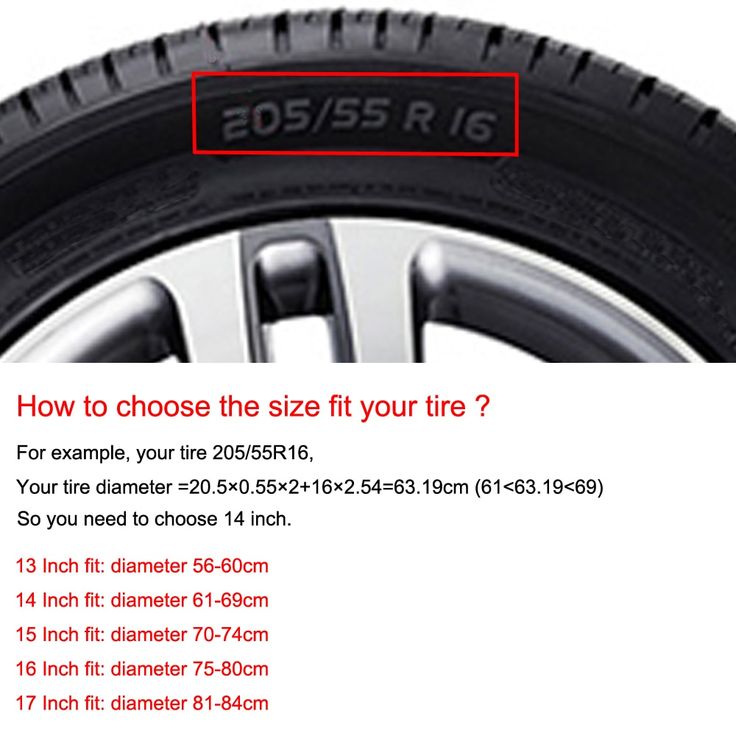
This is the time to verify if run-flat tires are present in your car since technology allows one to drive with flat tires at limited speeds and distances to allow you to access the nearest garage or car dealer. A source of light such as a headlamp or a flashlight is also essential before you even think of traveling on long distances.
Stop and pull over in a safe place that is flat and free from traffic.
An ideal place to change or install your spare tire is a parking lot, with level ground, asphalt, or concrete surface, and of course, the site should be free from traffic and away from the highway.
In case of an automatic car, place it in “Park” and don’t forget to apply parking brakes. It is important to ensure that it doesn’t move during the process of spare tire installation. You can place an object behind and in front of the car, tires to ensure the stability of the vehicle.
Make sure you position your reflective triangles if you’re near the parking lot or near the road to avoid unnecessary accidents.
Loosen the lug nuts without detaching them
Loosen the lug nuts using the wrench, and then you’ll remove them later using your hand when you’ve jacked up the car. Place the wrench into place, make sure it’s firm and turn from the left to the bottom. It takes a lot of force to break the lug nuts free.
Make sure you only loosen the lug nuts and don’t remove them.
Install the jack.
Sometimes it can be tricky to determine the exact spot the jack is supposed to be placed, especially in the recent model cars. Failure to place the jack in the correct position can crack the molded plastic at the bottom of the car when you lift the vehicle.
You should consult your manufacturer’s manual to find out the right position of the jack if not sure. Lift the car about 6 inches above the ground.
Remove the lug nuts carefully and take off the tire.
Detach the lug nuts and place them together. Keep in mind that dust and rusts can make it difficult to remove the tire off the car. You have to be a little patient.
You have to be a little patient.
Install the spare tire and place the lug nuts in place.
Replace the spare tire where you removed the regular tire, and place the lug nuts into place by hand without tightening them.
Lower the car before tightening the lug nuts.
Lower the jack slowly till the tire touches the bottom of the ground. Use the wrench to tighten the lug nuts into place securely. You might want to use your bodyweight for that additional force to make sure everything is tightened well.
Gather your things and drive carefully.
When you’re done with fixing your spare tire, you can drive away carefully. Make sure you adhere to the speed limits indicated on your car manual. You can also turn on the hazard lights to ensure you’re visible to other cars.
Here’s a sneak peek of how you can fix your spare tire in case you encounter a flat tire.
While spare tires are seen as simple things by most people, we’re not bothered until we find ourselves in a situation that needs one. We recommend that you keep a spare tire and ensure you regularly check its pressure, as it may come in handy in case of an emergency.
We recommend that you keep a spare tire and ensure you regularly check its pressure, as it may come in handy in case of an emergency.
Getting a flat tire is one of the many automotive problems that can strike without warning at any time of the day or night. Even if you are sure that you have nothing to fear in the event of a puncture, since you have a spare tire, damage to the wheel will interrupt your movement on the road anyway and cause a lot of trouble. The worst thing is that if you have a spare wheel, you will not be able to change it for a damaged wheel if you don't know how to do it. In this case, you will have to call a help desk or a tow truck, which will cost a considerable amount. Maybe it's better to learn how to change wheels on a car?
Learning how to change tires will not only save you time, but also greatly reduce your assistance costs. Our online publication offers you a guide with which you will learn that changing a self-damaged tire to a spare one is really not difficult.
But before we tell you how, here are some precautions you should take when changing wheels.
- Keep the spare tire in good condition . If you puncture a tire and your spare tire is not fit for installation, then this will bring unnecessary problems. Therefore, remember the spare wheel must be in good condition. When checking tire pressures, be sure to check the spare tire pressure as well.
- Remember that you must do this at least once a month. In addition, when checking the condition of the wheels on the car, do not deprive your attention of the spare wheel, which also should not have cracks and other damage that may occur due to temperature changes or tire age.
- Never change a tire on the freeway. Remember that changing a wheel on the highway, you risk being in a serious accident. After all, it is not uncommon when many inexperienced and aggressive drivers overtake cars on the right, which often leads to accidents as a result. Believe me, you will not have time to escape. Therefore, we advise you to call for emergency assistance in case of damage to the wheel.
Believe me, you will not have time to escape. Therefore, we advise you to call for emergency assistance in case of damage to the wheel.
- Also, if you have a punctured tire and you have the opportunity to remove the car from the freeway, then drive the car to a safe distance from the road and only in this case change the wheel . If this is not possible, then, having called for help, do not stay in the car, but move away from it at a safe distance from it.
- Use Tire Puncture Repair Kit. Many auto shops and tire shops sell special kits for the quick repair of tire punctures.
- Be sure to get them even if you have spare wheel . Remember that there are times when, having punctured a wheel, you are not able to jack up the car in order to install a spare tire.
- Please note that many modern cars in recent years are no longer equipped with spare wheels.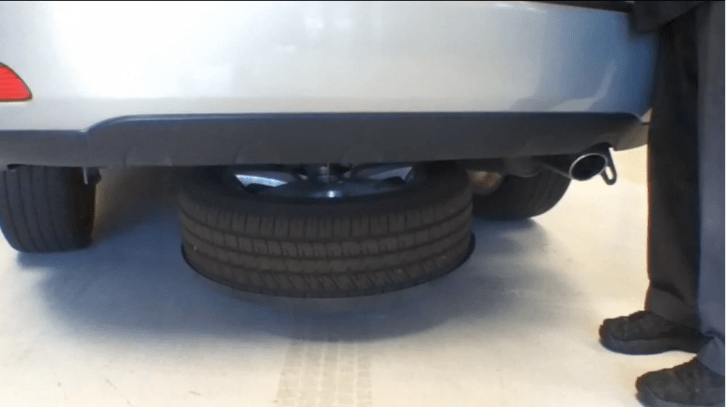 As a rule, instead of them, the manufacturer completes the car with special repair kits that can repair wheel damage.
As a rule, instead of them, the manufacturer completes the car with special repair kits that can repair wheel damage.
- These repair kits will not repair many types of damage to tires. So don't count on them too much. Still, the "spare wheel" is a more reliable way to avoid problems on the road. Therefore, even if the manufacturer has not equipped the car with a spare wheel, we recommend that you purchase the wheel yourself. And of course, remember that a pump or an electric compressor must be in the trunk of a car.
- Be careful when jacking up the machine . Replacing a wheel is associated with raising the car with a jack, which is inserted into a special groove or "platform". If you are not careful or attentive, you risk that the car will either fall off the jack or move to the side.
Have you given up on the idea of learning how to change a wheel yourself? No. Then let's get to the most important part.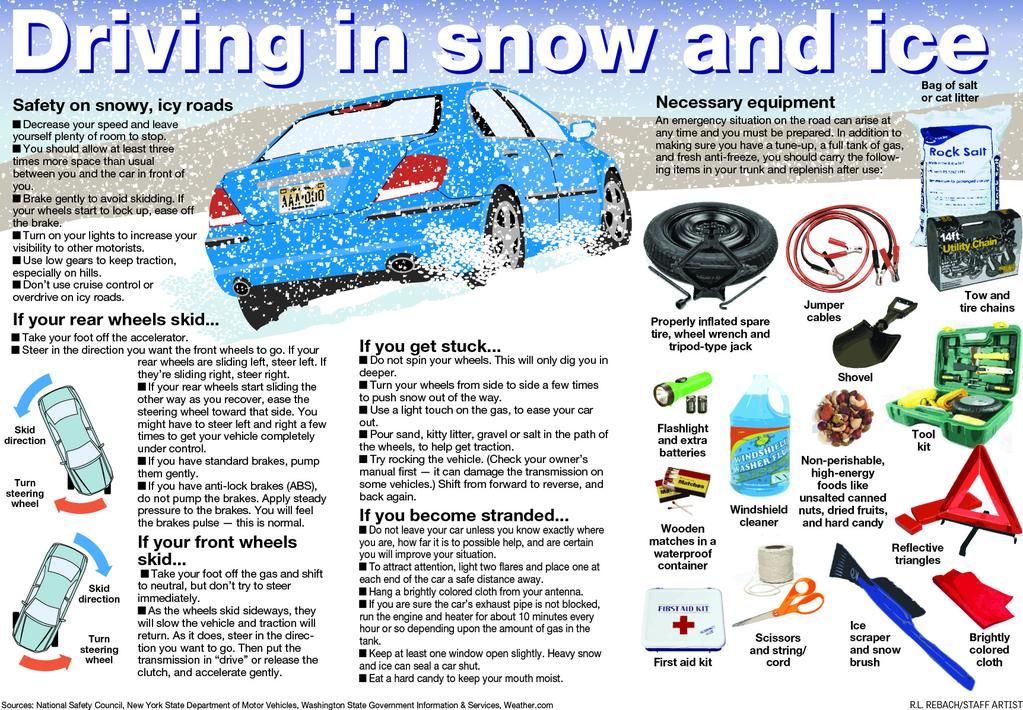
Before changing a wheel, make sure your car will not fall off the jack. To do this, make sure that the car is on a flat piece of land or asphalt. Also note that under the wheels of the car there should not be uneven surfaces, bumps or stones that can interfere with the process of jacking up the vehicle.
Including you have to make sure that the surface under the machine is hard enough. After all, by lifting one side of the car, its weight is redistributed to other wheels and in the case of a soft surface, the car can shift and fall off the jack. For example, be vigilant when changing a wheel on sand or when there is mud under the car. In order to understand whether the car can move on the jack, you need to slightly raise the car and shake it, watching the car and other wheels.
Along with the spare wheel, you must also carry a wheel wrench with which you can remove the wheel bolts . If you use secret bolts to protect the wheels from theft, then also do not forget to put a special key (secret) in the car so that you do not end up on the road in a hopeless situation when no one will help you except the tow truck.
If you use secret bolts to protect the wheels from theft, then also do not forget to put a special key (secret) in the car so that you do not end up on the road in a hopeless situation when no one will help you except the tow truck.
If for some reason you do not know if you have a wheelbrace for changing wheels (for example, you just bought a car), then it is probably located next to the spare wheel in the trunk, or in the glove compartment or in the side pockets of the doors .
wheel change . Including the manual on the car will tell you exactly where the special socket for the jack is located and how you can get the spare tire out of the car.
The most dangerous thing that can happen when changing a wheel is if the vehicle moves or starts to roll . To make sure this doesn't happen, you first need to apply the car's handbrake, locking the rear wheels.
Next, if your car is equipped with a manual transmission, you need to turn off the engine, put the gearbox in first or reverse gear. If your vehicle is equipped with an automatic transmission, then set the box to "P" - parking.
Many people think that putting the car on the "handbrake" is enough to start jacking up the car to change the wheel. But it's not. The fact is that the handbrake blocks only the rear wheels, while setting the gearbox to speed will also block the front drive wheels (if your car is front-wheel drive).
Having done all of the above, you must manually block the other wheels by placing something heavy under them to prevent the wheel from moving. Of course, you can put something heavy not under each wheel. It will be enough to put under the tire, which is diametrically opposed to the wheel being replaced.
That is, if you change the left front wheel, you must definitely place something heavy under the right rear wheel to prevent the wheel from moving. It is advisable that you find bricks or stones and put them in front of the wheel and behind it, thereby blocking it from both sides.
It is advisable that you find bricks or stones and put them in front of the wheel and behind it, thereby blocking it from both sides.
Attention! This is a very important point . Be sure to loosen the wheel bolts before jacking up the vehicle. That is, by raising the car with a jack, you should effortlessly complete the process of unscrewing the bolts. In order to unscrew the nut or wheel bolt, remove the wheel wrench, install it on the wheel fastener.
It is likely that you will need to position the key so that you can place a foot or two on it to turn the key under the weight of your body. Once the nut or bolt has begun to move, you can manually loosen it further.
The most important thing is not to over-tighten the wheel bolts, as your task is only to loosen them first. The main thing is that the wheels are still attached to the car and cannot fly off when the car is raised.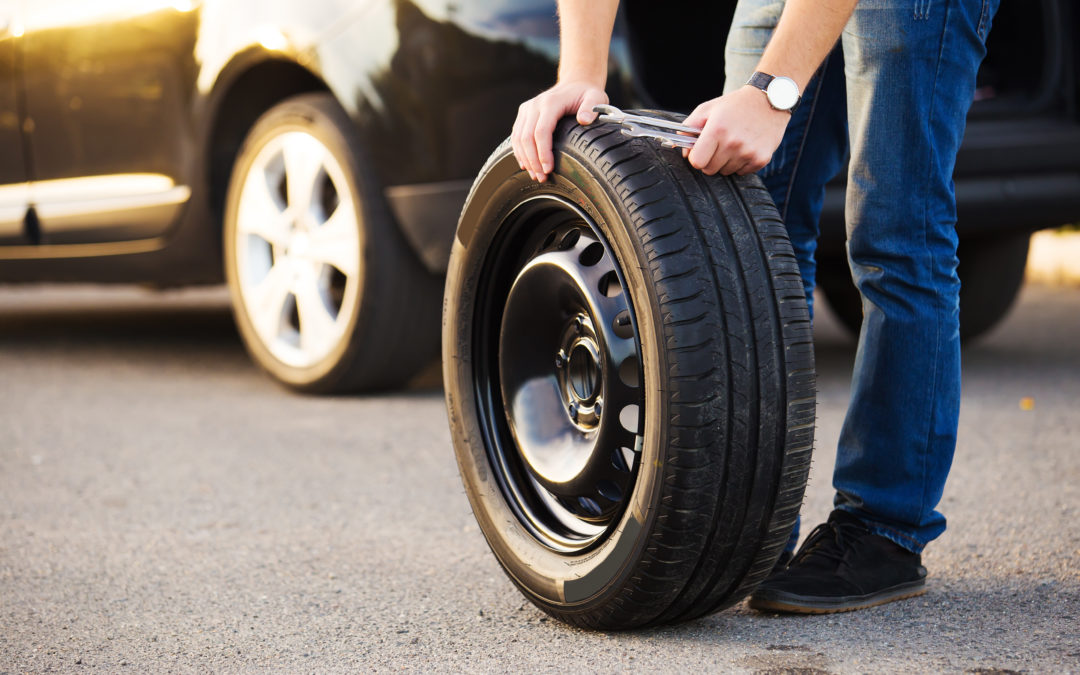
The jack is usually located in the trunk, either next to or under the spare tire, or in the special box . Also, in some cases, the jack may be located inside the cabin. Including there are also car models where the jack is under the hood.
In addition to loosening the wheel bolts, you must remove the spare wheel before jacking up the vehicle. The fact is that when the car is on the jack you should not rock the car in order to prevent it from falling.
Most modern cars have the spare wheel in the boot. As a rule, the trunk floor rises and a fixed spare wheel is located under it. In many cars, the spare wheel is fixed. How to remove the spare wheel from the car should be detailed in the manual for the car.
Find the correct place to mount the jack .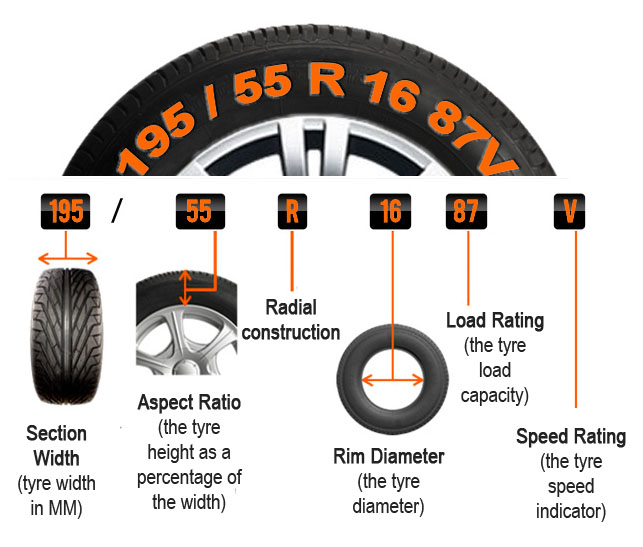 Remember that in every car there are special places on the body for this. As a rule, such places are located under the front or rear windows (behind the front and rear wheel arches). If you are in doubt and do not know where exactly to install the jack, check out the manual for the car, which explains everything in detail.
Remember that in every car there are special places on the body for this. As a rule, such places are located under the front or rear windows (behind the front and rear wheel arches). If you are in doubt and do not know where exactly to install the jack, check out the manual for the car, which explains everything in detail.
Following the instructions in the manual, after placing the jack, slowly raise the car . In some jack models, this may require the same wrench that you used to unscrew the wheel bolts. While lifting the machine slowly, check the position of the jack under the machine. If you see that the jack has begun to move, then lower the car and try to rearrange it in a better position.
Now it is time to remove the wheel from the hub . Using a wheelbrace, loosen the wheel bolts/nuts, but not all the way. Then slide the wheel off the hub. Be careful. Remember that the wheel weighs a lot and if you do not remove it carefully, you can injure your back from gravity. Next, remove the wheel bolts and remove the wheel completely from the car.
Then slide the wheel off the hub. Be careful. Remember that the wheel weighs a lot and if you do not remove it carefully, you can injure your back from gravity. Next, remove the wheel bolts and remove the wheel completely from the car.
The wheel is usually secured with four or five wheel bolts . Some models of cars have guides on the hub, through which you can easily hang the wheel on them first, and only then insert the wheel bolts.
True, many modern cars do not have such guides and therefore it will not be very easy to fix the spare wheel. You have to lean the wheel against the hub and rotate it so that the hole on the rim aligns with the hole on the hub.
Aligning the holes on the rim, insert the wheel bolts and tighten them by hand . Do not use a wheel wrench.
Remember to tighten the wheel bolts only after the machine is on all four wheels on the ground or pavement.
After lowering the machine from the jack, proceed to tighten the wheel nuts/bolts . Manually first, as much as possible. Further with the help of a balloon key. For optimum bolt tightening, with the wheel wrench on the wheel bolt, use your foot and your body weight to spin the wheel as securely as possible. As a rule, this step of tightening the bolts must be done several times.
Put the damaged wheel back in the car, also removing the jack and wheelbrace in place . Be sure to remove any bricks or rocks from under the wheels you have placed to prevent the wheels from spinning while the car is on the jack. Your vehicle is now ready to continue on your way down the road.
Please note that if the spare wheel is supplied from the factory, it is usually not designed for full use on the vehicle. Therefore, if you have installed a factory spare tire, do not accelerate above 60-70 km / h. In order to find out if it is possible to accelerate faster on the spare wheel, pay attention to the labels that are applied to the spare tire.
Therefore, if you have installed a factory spare tire, do not accelerate above 60-70 km / h. In order to find out if it is possible to accelerate faster on the spare wheel, pay attention to the labels that are applied to the spare tire.
They are usually labeled by the manufacturer. If you did not find such warnings, then refer again to the manual for the car, which, for sure, has recommendations at what speed you are allowed to travel on the spare wheel.
If, after changing a wheel while driving, you hear a repetitive knock, stop and use a wheelbrace to make sure the nuts or bolts on the wheel you have installed are tight enough (as far as possible).
Please note that the 1GAI.RU online publication does not bear any responsibility for any loss, damage or injury that may occur when replacing a damaged wheel based on this manual.
All information in this article is for informational purposes only. If in any doubt, consult a qualified mechanic before attempting to change a wheel yourself.
If in any doubt, consult a qualified mechanic before attempting to change a wheel yourself.
My first experience of a tire puncture was similar to the end of the movie "Station for Two". There, the hero of Oleg Basilashvili runs along the winter road, late for the roll call to prison, does not have time and starts playing the accordion right on the road. Here, everything was the same with me, only without music.
Tangled courtyards around a colony on the outskirts of the city, documents for an auction for the supply of meat and 7 minutes to get them to the checkpoint. And at this moment I hook the metal pin with the wheel, the rubber instantly falls off, I leave the car and run with the documents to the entrance to the colony. Everything worked out, but instead of a triumph, I had to install a spare wheel, and I only imagined how to put a spare tire. Imagine my surprise when a new, but smaller wheel was found in the trunk. At that moment I did not know yet that it is rare which spare tire matches the standard tires.
At that moment I did not know yet that it is rare which spare tire matches the standard tires.
A spare wheel is almost always included in new vehicles. And when the owner opens the trunk and looks into the pallet, 4 scenarios await him. Of course, if, like me, they did not pay attention to it in the showroom. There are also cars with a spare wheel in the back.
This is a rim with a smaller tire diameter, typically 1 inch from the main wheels. It cannot be considered a spare in the full sense, it is intended for temporary use in order to get to the nearest tire shop or shop where you can make a tire selection. Disks on the dokatka are usually steel. The whole point of such a wheel is to reduce the cost of completing a car in production. Many people also talk about reducing the weight of the equipped car, but this is a completely uncritical effect.
So, before installation, the pressure is checked in the dokatka. If possible, they pump up more than regular wheels, up to 4-4. 2 atmospheres. According to the operating rules, you cannot drive on different diameters, but you can move to the place of repair. Installing a spare tire will take time, and in order to shorten it, it is good to store the stowage assembled and already inflated.
2 atmospheres. According to the operating rules, you cannot drive on different diameters, but you can move to the place of repair. Installing a spare tire will take time, and in order to shorten it, it is good to store the stowage assembled and already inflated.
Equipped with the same tire as the vehicle itself. The disk can be simpler, the so-called basin or pan. If the rest of the wheels are cast, then it is also not recommended to use the spare wheel “on steel” for a long time. Different weight load on the axle, uneven running gear wear. What spare tire is suitable for constant driving? Only a full-fledged fifth wheel identical to the rest, and in two versions - winter and summer.
This is designed to quickly repair a punctured wheel, but will not help with significant damage. It is the case when it is better to play it safe - you still need an independent selection of tires. Spare wheel discs can be used the cheapest.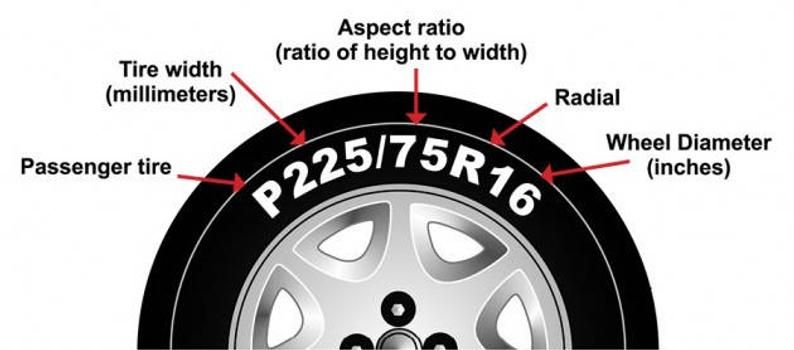
Fitting this spare tire mainly on luxury cars, they don't need spares. The composition of the rubber and the design of the cord are such that they allow the car to drive before repair even with a flat tire: the tire will not fall off, the grip will remain.
If there is a space for storing a spare wheel in a special compartment in the trunk, on the roof or on the tailgate, then it must be included in the package of a new car. Used cars can be in a different condition, but they usually have a spare tire available. What should be the spare wheel so that it can be used as quickly as possible?
1. Existing. That is, in principle, it should be. There are drivers who do not even know what kind of spare tire is in their car and whether it is at all. Nevertheless, informed means armed, everyone knows this.
2. Pumped up. It is recommended to check the pressure in it monthly along with the diagnostics of standard wheels.